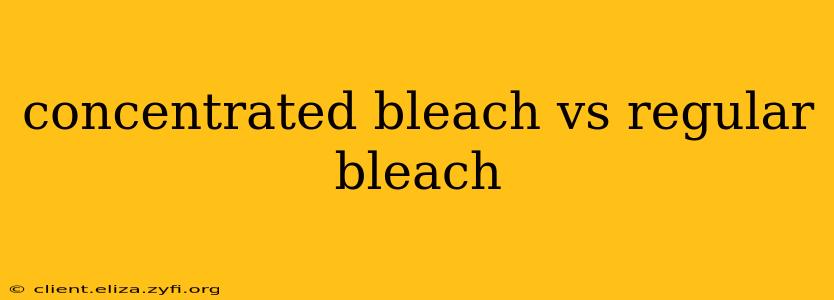Household bleach is a powerful cleaning agent, but not all bleaches are created equal. Understanding the difference between concentrated bleach and regular bleach is crucial for safe and effective cleaning. This article will delve into the key distinctions, highlighting their strengths, weaknesses, and appropriate uses.
What is Concentrated Bleach?
Concentrated bleach, also known as industrial strength bleach or high-concentration bleach, contains a significantly higher percentage of sodium hypochlorite (NaOCl) than regular household bleach. While regular bleach typically contains around 5-6% sodium hypochlorite, concentrated bleach can range from 8% to even 15% or more. This higher concentration means it's more potent and effective at disinfecting and bleaching, but also presents greater risks if mishandled.
What is Regular Bleach?
Regular bleach, commonly found in supermarkets and grocery stores, is a diluted solution of sodium hypochlorite. Its lower concentration makes it safer for household use, although still requiring careful handling. The lower concentration means it's less aggressive on fabrics and surfaces, reducing the risk of damage.
Concentrated Bleach vs. Regular Bleach: Key Differences
Here's a table summarizing the key differences:
| Feature | Concentrated Bleach | Regular Bleach |
|---|---|---|
| Sodium Hypochlorite Concentration | 8-15% or higher | 5-6% |
| Effectiveness | More potent for disinfecting and bleaching | Less potent, suitable for general household use |
| Safety | Requires more cautious handling; greater risk | Relatively safer for household use |
| Cost | Generally more expensive per unit volume | Less expensive per unit volume |
| Application | Industrial settings, heavy-duty cleaning tasks | General household cleaning, laundry |
How to Safely Use Concentrated Bleach?
Always follow the manufacturer's instructions carefully. Never mix concentrated bleach with other cleaning products, especially ammonia or acids, as this can create toxic gases. Always wear appropriate safety gear, including gloves, eye protection, and a respirator in well-ventilated areas. Dilute concentrated bleach according to the instructions before use.
Is Concentrated Bleach Necessary for Home Use?
For most household cleaning tasks, regular bleach is sufficient and safer. Concentrated bleach is typically only necessary for industrial or commercial applications where a higher level of disinfection or bleaching is required. Using concentrated bleach in a domestic setting without proper knowledge and safety precautions can be dangerous.
What are the Risks of Using Concentrated Bleach?
The higher concentration of sodium hypochlorite in concentrated bleach significantly increases the risks associated with its use. These risks include:
- Chemical burns: Contact with skin or eyes can cause severe burns.
- Respiratory problems: Inhaling bleach fumes can irritate the lungs and cause respiratory problems.
- Toxic gas formation: Mixing concentrated bleach with other chemicals can produce toxic and potentially lethal gases.
- Damage to surfaces: The high concentration can damage certain materials, leading to discoloration or deterioration.
Can I dilute concentrated bleach to make regular bleach?
Yes, you can dilute concentrated bleach to create a solution similar to regular household bleach. However, this requires precise measurements and careful handling to avoid accidents. Always refer to the manufacturer’s instructions for dilution ratios. Improper dilution can still result in a solution that is too strong for safe household use.
Which type of bleach is best for laundry?
For most laundry needs, regular household bleach is perfectly adequate. Its lower concentration is less likely to damage fabrics while still effectively whitening and sanitizing clothes. Concentrated bleach should be avoided for laundry unless specifically recommended by the manufacturer of a particular cleaning product for a specific application, and with rigorous safety precautions.
What are the environmental concerns of using bleach?
Both concentrated and regular bleach have environmental impacts. Improper disposal can pollute water sources, harming aquatic life. The production of bleach also requires energy and resources. Choosing eco-friendly alternatives, using bleach sparingly, and disposing of it responsibly are important considerations.
This guide aims to provide a comprehensive understanding of the differences between concentrated and regular bleach. Always prioritize safety and follow manufacturer instructions when using any bleach product. For specific applications or concerns, consult with a cleaning professional or relevant safety authority.
